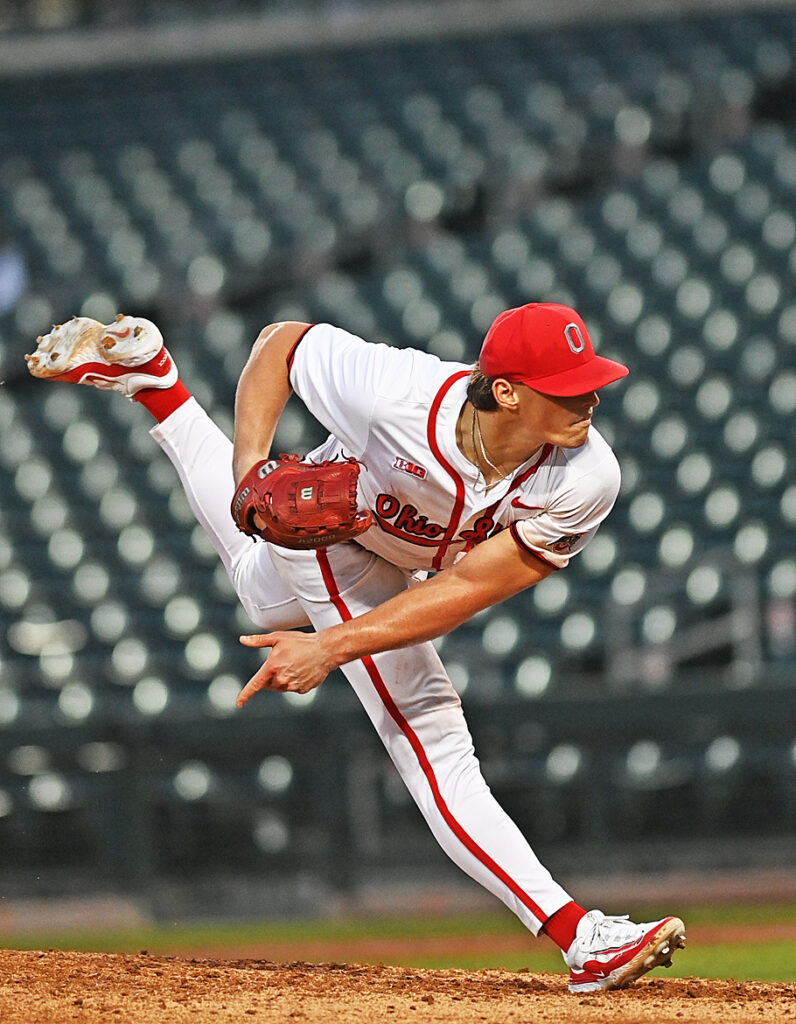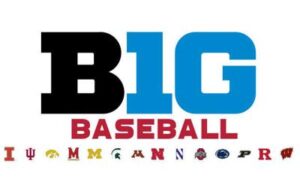
We want the best experience we can provide for our players, and we want to see what we’re made of,” says OSU’s Bill Mosiello of the Buckeyes’ rugged non-conference schedule. They play a four-game set with Arizona State this weekend. (Press Pros File Photos)
With a day off to muse over the first four games of the 2024 season, we address, head-on, questions about the value of the baseball Buckeyes’ 2-2 start.
 Phoenix, AZ – Traveling home for a few days to recharge and repack, I was pleased to find the daily service of comments from those at home reading the coverage of Ohio State baseball, and for the most part, enjoying it.
Phoenix, AZ – Traveling home for a few days to recharge and repack, I was pleased to find the daily service of comments from those at home reading the coverage of Ohio State baseball, and for the most part, enjoying it.
They’re 2-2 at this writing, and a quality 2-2, having beaten a solid Brigham Young team, and a Southern California team that’s going to very competitive in the final year of PAC-12 competition.
Trust me, the Big Ten bluebloods are not going to enjoy the infusion of West Coast baseball in 2025…because there is an ‘air’ about it, the legacy, pride, and futuristic expectation of being a big fish in a small pond come next spring. But I digress……
Among the morning’s mail was also an email from a regular baseball reader in central Ohio that wrote:
“Two good games and two bad games. What’s different? You tend to be a little overly optimistic, which tells me you’re too close to the flame. I wish you’d just tell the truth about Ohio State baseball, and quit writing that they’re young. Of course they’re young!”
 First, my initial impression. I love the passion, but question if you’re not so far from the fire of contemporary college baseball that your perspective is as cold as an Eskimo’s outhouse.
First, my initial impression. I love the passion, but question if you’re not so far from the fire of contemporary college baseball that your perspective is as cold as an Eskimo’s outhouse.
With appreciation for those who remind me of Bob Todd’s record, and that Greg Beals won 350 games (.545 in eleven seasons), the culture of Division I baseball now, nationally, compared to what it was just five years ago, is like night and day.
I remember five years ago (maybe six) when the Buckeyes opened with teams like Wisconsin-Milwaukee and Canisius. With due respect for those two schools, there were no pitchers throwing 96 miles per hour. There were no lefthanded specialists like Boston College’s Eric Mudd last week, throwing a slider that Steve Carlton would have admired.
Now, in a period of just seven years everyone in college baseball has a pitching staff full of arms capable of overpowering the best college hitters in America.
And for their part, almost every hitter in the opposing batting order looks at 95 miles per hour presently as being ‘hitting speed’. If you can’t execute the secondary pitches, and change speeds, you’re a sitting duck, regardless of how hard you throw.
For the fact of being young, let me explain why they’re young. Every school, as you mention, recruits from a culture of amateur baseball that in large part comes to college without the proper schooling to compete at this level. Frankly, there aren’t as many high school coaches as there once was capable of teaching the finer points of the game.

The Buckeyes’ Gavin Bruni is not the same pitcher he was even a year ago, and proudly talks about the process of maturing as a player.
And the other culture of baseball – ‘travel ball’ – apparently comes up short in that respect, as well. Because I see those kids come to college and look at coaches like Mosiello, Beals, Jake Boss (Michigan State), and Rick Heller (Iowa) like they’ve never been questioned about throwing to the wrong base, catchers receiving the baseball with ‘quiet’ hands instead of stabbing at it, or even proper footwork in catching a ground ball, let alone turning the double play. It would seem that a lot of this has to be unlearned and retaught to young players hearing it for the first time.
And then…there’s the issue of what really constitutes success now, compared to what you remember from the Bob Todd days. More than one critic writes to say that the Buckeyes haven’t won a Big Ten regular season title since 2009, roughly 15 years. But while winning the league is still notable, it doesn’t carry near the weight that it once did. Today success is measured in making the NCAA post-season tournament, winning a regional tournament, or a super regional…and did you get go the College World Series?
This is no different, by the way, than other sports. I guarantee you that no one remembers how many Big Ten titles Ohio State has won in football, but all of them can tell you the years they won the national title.

The McKinley Funeral Home, in Lucasville, proudly supports Buckeye football on Press Pros Magazine.com.
You want to hear the truth about Ohio State baseball?
They’re talented, and they are young, compared to the kind of baseball culture you find at LSU, or Florida, or Vanderbilt. It does take time. The Gavin Bruni who pitched and won last week against Southern Cal last week in no wise resembles the Gavin Bruni who pitched two years ago, a fact he acknowledges and is even proud to talk about.
The personality of this team is different from the past, in large part because of Bill Mosiello, himself. He wears his expectations and priorities publicly, and freely admits that he needs to get better daily in the same manner that he expects from his players.
And what yet remains to be seen is the level of baseball priority that comes with new athletic director Ross Bjork, who comes from a strong and successful culture of baseball at Texas A&M, having appeared in the NCAA tournament eight of the last ten years, and 37 appearances, all-time.
It’s true, too, that Bob Todd did win 801 games in twenty two years as coach. And to compare the present to even twenty years ago, Todd started 1-3 on the season’s first weekend, losing to Texas (0-6), Kansas State (6-12), and Texas Tech (4-9) before beating the University of Richmond. They began the Big Ten schedule that year with a mark of 7-10.
 After this weekend’s four-game set with Arizona State the Buckeyes play Cal, Pitt, and Oklahoma next weekend in Las Vegas.
After this weekend’s four-game set with Arizona State the Buckeyes play Cal, Pitt, and Oklahoma next weekend in Las Vegas.
Challenging?
“Yes,” admits Mosiello. “But we want the best experience possible for our players, and we want to find out what we’re made of.”
But hey, the fact that people even write tells me they’re paying attention, and care.
Now you tell me the truth. How could you ask for more?


